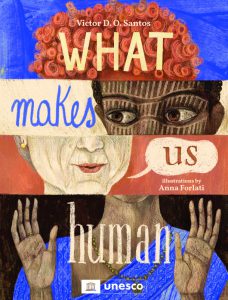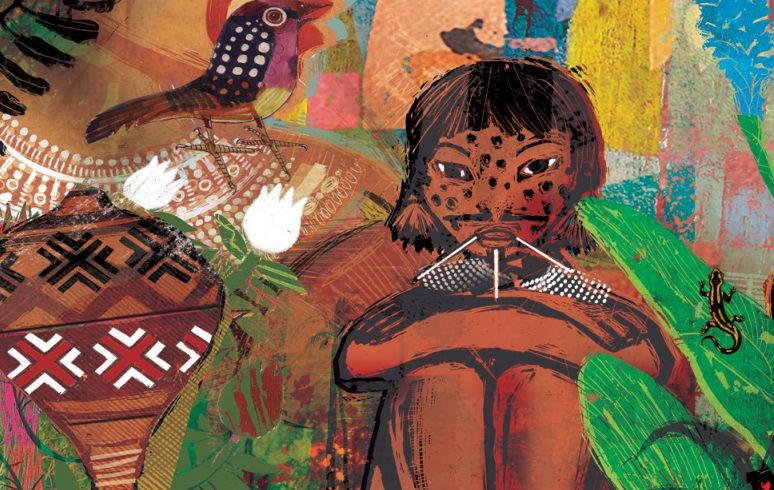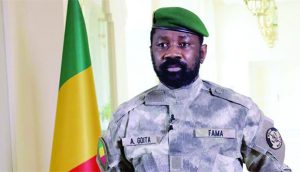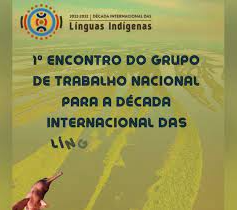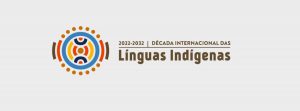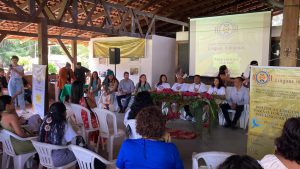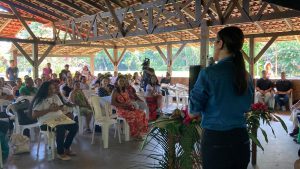O que nos faz humanos?
Publicado em 4 de agosto de 2023
Como parte de seu plano de ação para a Década Internacional das Línguas Indígenas 2022-2032, a UNESCO firmou parceria com editoras excepcionais de todo o mundo para apresentar “O que nos faz humanos”, o livro infantil ilustrado de Victor D. O. Santos e Anna Forlati.
Muitas vezes, os livros infantis marcantes e inovadores devem sua existência à frustração de adultos criativos quando tentam encontrar o livro adequado para presentear seus próprios filhos. Um dos exemplos mais notáveis que rapidamente vem à mente é o de “Der Struwwelpeter” (de 1844, traduzido como “João Felpudo”), do psiquiatra alemão Heinrich Hoffmann. Trata-se de uma coleção aterrorizante e delirante de histórias curtas inventadas de forma engenhosa para ensinar às crianças o que fazer e o que não fazer, ao mesmo tempo em que as estimula a questionar a legitimidade da autoridade dos adultos. É uma combinação de ideias poderosas que o autor criou por falta de melhores opções..
Algo bastante semelhante está na origem de um novo livro de imagens, de cuja produção a UNESCO tem orgulho de ser parceira: “O que nos faz humanos”. Este é um livro que, em 2022, antes de seu lançamento no Brasil, foi selecionado pelo júri especializado da mostra “The Unpublished Picture Book Showcase by dPICTUS“, pelas ilustrações deslumbrantes da artista italiana Anna Forlati e pelo texto contundente do autor e linguista brasileiro Victor D.O. Santos. Além disso, o livro foi selecionado para ser exposto na Feira do Livro Infantil de Bolonha de 2023, “Beauty and the World: The New Nonfiction Picture Book” (A beleza e o mundo: o novo livro ilustrado de não ficção).
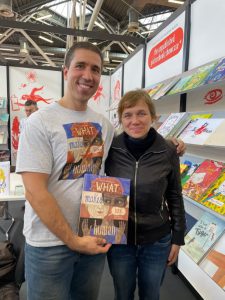
Victor and Anna at the Unpublished Picture Book Showcase by dPICTUS stand, Bologna Children’s Book Fair 2022. © Victor Santos
Em um mundo no qual 40% das cerca de 7 mil línguas faladas podem desaparecer na virada do século XXI devido à falta de falantes, Victor Santos, um linguista apaixonado, perguntou-se como poderia transmitir a seus próprios filhos a noção simples, mas poderosa, de que nossa língua está no cerne do que nos define como humanos. Que cada língua, independentemente do número de falantes que possua, é um veículo para a cultura: uma multiplicidade de tradições, crenças e visões de mundo que merecem ser preservadas. Segundo Victor, quanto mais diversidade linguística houver, mais ricos nós seremos como seres humanos. A consciência e o respeito pela diversidade humana, como a UNESCO afirma desde a sua fundação, é a chave para a compreensão mútua.
Leia mais puxando a Rede:
Conheça a página da ilustradora Anna Forlati: http://www.annaforlati.com
E também a página de Victor: https://www.linguacious.net
Seu Facebook: https://www.facebook.com/linguacious/
E uma entrevista com trajetória e ideias: https://languagemuseum.org/interview-with-victor-santos-founder-and-ceo-of-linguacious-llc/
Plataforma oferece cursos e materiais gratuitos que valorizam as tradições de povos indígenas
Conteúdos são oferecidos para apoiar o trabalho de professores, mas também como forma de incentivo aos interessados pelo tema em conhecer a cultura dos povos originários.
“Utilizar ervas ou banha de cobra para fins medicinais parece uma cena boba, mas é uma dessas lições em relação à valorização que devemos dar para a medicina tradicional indígena. É preciso parar com essa ignorância, com o preconceito, olhar para isso com melhores olhos, sabendo que há bons resultados que precisam ser reconhecidos”, conta o escritor e professor Yaguarê Yamã.
Ele foi um dos participantes da série de encontros ‘Jenipapos: Redes de Saberes’, realizada pelo Itaú Social e pelo instituto Mina – Comunicação e Arte. Nessas atividades, também estiveram presentes outros representantes da literatura indígena e negra, como Conceição Evaristo, Ailton Krenak, Daniel Munduruku, Dona Liça Pataxoop, Dona Vanda Pajé, Eliane Potiguara e Julie Dorrico.
“A escola é um espaço privilegiado para combater preconceitos contra manifestações culturais. A aprovação da lei 11.645/08, que trata da inclusão do estudo da história e cultura indígena na escola, foi um importante avanço no ensino que valorize as tradições dos povos originários, no entanto, ainda há um longo caminho para percorrer até chegarmos ao objetivo da equidade racial na educação”,
comenta a gerente de Implementação do Itaú Social, Cláudia Sintoni.
A série de debates resultou na criação dos cursos ‘Jenipapos – Literatura de Autoria Indígena‘ e ‘Jenipapos – Redes de Saberes‘, oferecidos gratuitamente. Ambos despertaram o interesse de mais de 11 mil pessoas, sendo que mais da metade são professores.
“Procuramos dar um olhar de maior representatividade para as culturas indígenas, trazendo para o centro do debate os saberes e a pedagogia indígena, para que a gente veja que é possível fazer uma interlocução, criar uma ponte entre os diferentes saberes. Queremos mostrar que podemos sim, construir uma educação transformadora”, explica Daniel Munduruku, um dos participantes da série e escritor selecionado três vezes pelo prêmio Jabuti.
Todos os materiais da plataforma são fruto de pesquisas aplicadas e desenvolvidas entre 2020 e 2022 em escolas públicas de todas as regiões do país. A realização desses projetos pedagógicos contou com o apoio do Edital de Equidade Racial, do Itaú Social e Ceert (Centro de Estudos das Relações de Trabalho e Desigualdades).
Leia a matéria em: https://portalamazonia.com/noticias/educacao/plataforma-oferece-cursos-e-materiais-gratuitos-que-valorizam-as-tradicoes-de-povos-indigenas
Sobre o Jenipapos:
https://polo.org.br/multiletramentos/formacao/278/jenipapos-redes-de-saberes
https://polo.org.br/multiletramentos/formacao/217/jenipapos-literatura-de-autoria-indigena
Puxando a Rede, saiba mais sobre a plataforma POLO, Itaú Cultural
https://www.itausocial.org.br/relatorio2020/pesquisa-e-desenvolvimento/polo/
Polo, ambiente de formação do Itaú Social
Mali abandona o francês como língua oficial do país
Com a nova Constituição, o Mali abandona o francês, que é a língua oficial do país desde 1960, de acordo com a nova Carta Magna, promulgada no dia 22 de Julho, passando a ser relegada à língua de trabalho.
Sob a nova Constituição, aprovada de forma esmagadora com 96,91% dos votos, no referendo de 18 de Junho, o francês não é mais a língua oficial do país. Embora o francês seja a língua de trabalho, outras 13 línguas nacionais faladas no país vão receber o estatuto de língua oficial.
O Mali, que tem cerca de 70 línguas locais faladas no país, incluindo Bambara, Bobo, Dogon e Minianka, algumas delas receberam o estatuto de língua nacional por um decreto de 1982.
Para o académico Boubacar Bocoum, “a língua francesa não foi uma língua escolhida. Antes de tudo, foi uma língua colonial que se impôs, depois, quando o colonizador saiu nos anos 1960, eles nos deixaram essa língua e a administração francesa, o que significa que todo o modo de governar foi modelado precisamente no protótipo da pobre governança colonial”. Recorde-se que o líder da junta do Mali, coronel Assimi Goita, colocou em vigor a nova Constituição do país, marcando o início da Quarta República naquela nação da África Ocidental.
De acordo com a Presidência, os militares do Mali, desde que assumiram o poder e através de um golpe em Agosto de 2020, sustentaram que a Constituição seria fundamental para a reconstrução do país. O Mali testemunhou dois golpes subsequentes nos últimos anos, um em Agosto de 2020 e outro em Maio de 2021. A Junta Militar tinha prometido realizar eleições em Fevereiro de 2022, mas depois as marcou para Fevereiro de 2024. A decisão do Mali de abandonar o francês ocorre num momento de crescentes sentimentos anti-França na África Ocidental, devido à percepção de interferência militar e política.
Leia a matéria na fonte:
________________
Saiba mais puxando a rede:
A nova constituição Mali
https://sgg-mali.ml/JO/2023/mali-jo-2023-13-sp-2.pdf
Article 31 : Les langues nationales sont les langues officielles du Mali.
Une loi organique détermine les conditions et les modalités de leur emploi.
Le français est la langue de travail.
L’Etat peut adopter toute autre langue comme langue de travail.
Article 32 : La laïcité ne s’oppose pas à la religion et aux croyances. Elle a pour objectif de promouvoir et de conforter le vivre-ensemble fondé sur la tolérance, le dialogue et la compréhension mutuelle.
L’Etat garantit le respect de toutes les religions, des croyances, la liberté de conscience et le libre exercice des cultes dans le respect de la loi.
Refondation du Mali | Les langues nationales du Mali sont désormais érigées en langues officielles
http://news.abamako.com/h/281201.html
https://www.okayafrica.com/mali-replaces-french-as-official-language/
https://www.africanews.com/2023/07/26/mali-drops-french-as-official-language//
I Encontro do Grupo de Trabalho Nacional para a Década Internacional das Línguas Indígenas (DILI – 2022-2032)
Começou o I Encontro (DILI – 2022-2032)” que está sendo realizado na cidade de Manaus, entre os dias 9 a 11 de agosto de 2023. Com o objetivo de discutir e elaborar um conjunto de diretrizes para a criação de políticas linguísticas para línguas indígenas no Brasil, o evento reúne indígenas e não indígenas envolvidos com o GT Nacional.
Estado do Amazonas passa a ter 17 línguas oficiais
Estado do Amazonas passa a ter 17 línguas oficiais
Ato na última quarta-feira 19 oficializou 16 delas
POR AGÊNCIA BRASIL
A partir de agora, o estado do Amazonas tem 17 línguas oficiais. E o português é apenas uma delas. Dezesseis línguas indígenas foram incluídas como oficiais em ato realizado nesta quarta-feira 19, em São Gabriel da Cachoeira, que fica a 800 quilômetros de Manaus e é considerada a cidade mais indígena do Brasil.
Saiba mais puxando a rede:
Leia a matéria na fonte da Agência Brasil EBC: https://agenciabrasil.ebc.com.br/es/geral/noticia/2023-07/estado-brasileno-de-amazonas-tiene-17-lenguas-oficiales
Carta Capital: https://www.cartacapital.com.br/sociedade/estado-do-amazonas-passa-a-ter-17-linguas-oficiais/


